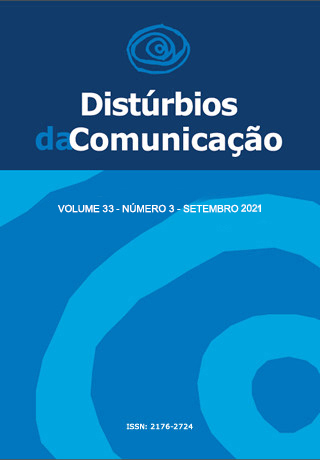The intensity of vocal fatigue symptoms and acoustic parameters of teachers before and after vocal loading
DOI:
https://doi.org/10.23925/2176-2724.2021v33i3p428-436Keywords:
Fatigue, Voice, Faculty, Dysphonia, WomanAbstract
Introduction: Vocal fatigue is a set of vocal symptoms manifested after prolonged and/or intense vocal use that is frequently observed in teachers. Objective: to describe and compare acoustic parameters and self-perception of vocal fatigue symptoms before and after a vocal exposure by the teacher in the occupational environment. Methods: 30 women, with an average of 40.37 years old, public school teachers, were submitted to the recording of acoustic parameters and self-perception evaluation of the intensity of vocal fatigue symptoms before and after vocal use in the classroom. The Advanced Mult-Dimensional Voice Programm (MDVP-Adv) was used to extract acoustic parameters. Results: only the SPI parameter of noise showed a significant decrease after vocal use (p=0.02). Symptoms of hoarseness, vocal failures, sore/ burning throat, tiredness to maintain speech increased after occupational voice use. Conclusion: after occupational voice use, the SPI breathiness rate decreased and the vocal fatigue symptoms increased.
Downloads
References
Fuess, VLR, Lorenz, MC. Disfonia em professores do ensino municipal: prevalência e fatores de risco. Braz J Otorhinolaryngol. 2003; 69(6): 807-12.
Araújo, TM., Reis, EJFB., Carvalho, FM, Porto, LA., Reis, IC. Andrade, JM. Fatores associados a alterações vocais em professoras. Cad. Mídia Saúde Pública. 2008; 24(6): 1229-38.
Lehto, L., Laaksonen, L.,Vilkman, E., ALKU, P. Occupational voice complaints and objective acoustic measurements do they correlate? Logoped Phoniatr Vocol. 2006; 31(1): 147-52.
Russell, A., Oates, J., Greenwood, KM. Prevalence of voice problems in teachers. J Voice.1998; 12: 467-79.
Medeiros, JSA., Santos, SMM., Teixeira, L C, Gama, ACC., Medeiros, AM. Sintomas vocais relatados por professoras com disfonia e fatores associados. Audiol Commun Res. 2016 [acesso em 2020 ago 17]; 21, e1553
Alves, LA., Oliveira, G, Behlau, M. A voz das professoras durante a atividade letiva. Rev. baiana saúde pública. 2010; 34(4): 865-78.
Simões, M., Latorre, M. D. O.Prevalência de alteração vocal em educadoras e sua relação com auto-percepção. Rev. Saúde Pública. 2006; 40(6): 1013-8.
Ferreira, LP, Giannini, SPP, Alves, NLL, Brito, AF, Andrade, BMR, Latorre, MRDO. Distúrbio de voz e trabalho docente. CEFAC; 2016,18(4): 932-40.
Ribeiro, VV,Cielo, CA. Medidas vocais perceptivo-auditivas e acústicas, queixas vocais e características profissionais de professoras de Santa Maria (RS). Audiol Commun Res.2014; 19(4): 387- 98.
Jardim, R., Barreto, SM, Assunção, AA.Voice Disorder: case definition and prevalence in teachers. Rev Bras Epidemiol. 2007;10(4): 625-36.
Smith, E., Kirchner, HL., Taylor, M, Hoffman, H, Lemke, JH. Voice problems among teachers: differences by gender and teaching characteristics J Voice.1998,12: 328-34.
Carregosa, ES., Silva, VL., Brito, A., Dornelas, R., Irineu, RA. Autopercepção da função glótica e análise perceptivoauditiva de professores de escolas municipais. CEFAC. 2016; 18(2): 481-90.
Kostyk, BE., Rochet, AP. Laryngeal airway resistance in teachers with vocal fatigue: A preliminary study. J Voice.1998; 12: 287–99.
Pellicani, AD., Ricz, HMA., Ricz, LNA. Função fonatória após o uso prolongado da voz em mulheres brasileiras. CoDAS.2015; 27(4): 392-9.
Aragão, NA., Couto, TE., Camargo, ZA., Santos, MAR., Gama, ACC. Análise da qualidade vocal antes e após o uso profissional e social da voz. Audiol Commun Res.2014; 19(3): 209-14.
Welham, NV., Maclagan, MA. Vocal Fatigue: Current Knowledge and Future Directions. JVoice. 2003; 17:21–30.
Solomon, NP. Vocal fatigue and its relation to vocal hyperfunction. Internat J Speech Lang Path.2008; 10: 254-66.
Chang, A., Karnell, MP. Perceived Phonatory Effort and Phonation Threshold Pressure Across a Prolonged Voice Loading Task: A Study of Vocal Fatigue. J Voice. 2004; 18: 454–66.
Zambon, F., Moreti, F., Ribeiro, VV, Nanjundeswaran, C, Behlau, M. Vocal fatigue index: validation and cut-off values of the Brazilian version. J Voice. No prelo. 2020.
Nanjundeswaran, C, Jacobson, BH, Schmidt, JG., Abbott, KV. Vocal Fatigue Index (VFI): Development and Validation. Journal of Voice.2015; 29(4): 433-40.
Paolillo NP, Pantaleo G. Development and validation of the voice fatigue handicap questionnaire (VFHQ): clinical, psychometric, and psychosocial facets. J Voice. 2015; 29(1): 91-100.
Stemple JC, Stanley J, Lee L. Objective measures of voice production in normal subjects following prolonged voice use. J Voice. 1995; 9(2): 127-33.
Vilkman, E.ER. Lauri, et al. Effects of prolonged oral reading on F0, SPL, subglottal pressure and amplitude characteristics of glottal flow waveforms. J Voice. 1999; 13(2): 303-12.
Laukkanen AM, Ilomaki I, Leppanen K, Vilkman E. Acoustic measures and self-reports of vocal fatigue by female teachers. J Voice. 2008; 22(3): 283-9.
Titze IR. Workshop on acoustic voice analysis. Natl Cent Voice Speech Am. 1994,1-36.
Aguiar-Ricz, LN, Pellicani A. Psychometric instrument for the measurement and evaluation of auditory perception and tactile- kinesthetic vocal resistance. In: 1st Congress of the Confederation of European Otorhinolaryngology and Head and Neck SurgeryGlottic,2011 ago; Barcelona, Espanha: 2011. p. 448
Ghirardi, ACAM, Ferreira, LP., Giannini, SPP., Latorre, MRDO. Screening Index for Voice Disorder (SIVD): Development and Validation. J Voice. 2003; 27: 195-200.
Bhuta T, Patrick L, Garnett JD. Perceptual evaluation of voice quality and its correlation with acoustic measurements. J Voice. 2004,18(3): 299-304.
Freitas, CNJ, Almeida, AA, Ferreira, DAH, Medeiros, CMA, Silva, MFB Lima. Condições de trabalho e de voz em professores de escolas públicas e privadas. Audiol., Commun. Res. [Internet]. 2019; 24: e2151.
Fernandes, LC, Bomfim, DAS, Machado, GC, Andrade, CL. Influência da retroalimentação auditiva nos parâmetros acústicos vocais de indivíduos sem queixas vocais. Audiol., Commun. Res. [Internet]. 2018; 23: e1785
Pellicani AD, Fontes AR, Santos FF, Aguiar-ricz LN. Fundamental Frequency and Formants Before and After Prolonged Voice Use in Teachers. J Voice. 2018,32(2): 177-84.
Downloads
Published
Issue
Section
License
Copyright (c) 2021 Ariane Damasceno Pellicani, Alice Fontes Ramos, Francisco Flavio Santos, Rodrigo Dornelas, Aline Ferreira de Brito-Mota

This work is licensed under a Creative Commons Attribution 4.0 International License.









